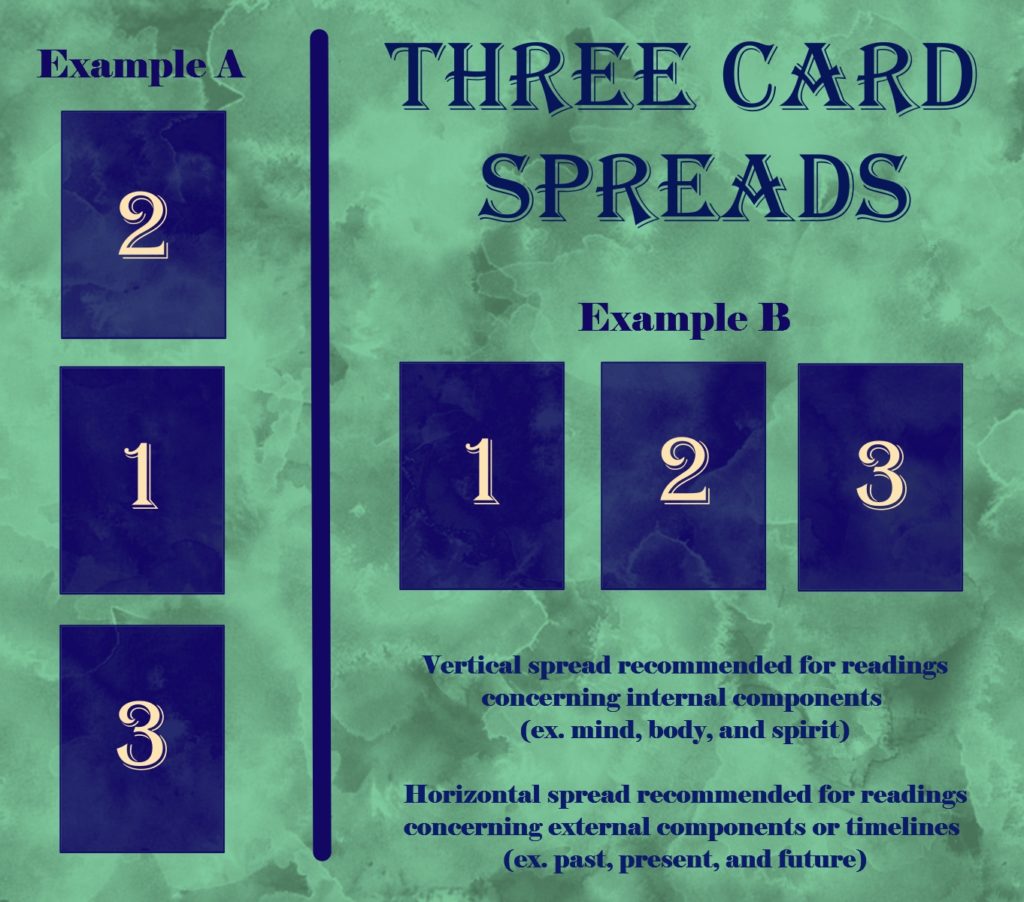Welcome back to the world of tarot! Yesterday we talked about the basics of selecting a deck and getting set up to try out single card readings. Today we get a little more complicated with two and three card readings. Let’s get started!
You’ll need a tarot card deck (purchased, printed, or app) and guidebook or website with meanings. (Check out yesterday’s post for a deeper dive in picking a deck, etc!)
When moving from single card readings into layouts with multiple cards, there is more complexity than having multiple single card readings lined up. Cards influence the meaning of those around them and come together like pieces of a mystical puzzle. When starting this kind of reading the same process is used as described yesterday, including having a question or specific focus in mind from the beginning.

Once the cards are shuffled and ready to draw, pull each card carefully – one by one. The first card is placed in spot one of the layout you decide on, the second is placed in spot two, etc. It is important to have decisions made about what question you are asking and what layout you will use ahead of time. As you can see in the image below, I recommend using vertical layouts in two-three card spreads for internal matters and horizontal spreads for external matters. In my mind I picture vertical spreads as a person standing tall so that the top card would be over their head and the bottom would be over their feet. The horizontal layout reminds me of timelines or external factors pulling one forward or holding one back.

After the cards are drawn, set the deck with undrawn cards aside and look at the spread as a whole. What are your impressions? What stands out? Is one suit repeated? Does it look symmetrical or asymmetrical in color, tone, and theme? Taking this step can give you some overall ideas about your reading and can help you remember that each card relates to those around it.
Now you are ready to look in your guidebook or website for the individual card meanings. I would recommend writing them down if you are not familiar with tarot cards so that you don’t have to keep flipping back and forth between meanings. After you determine the meaning of each card you can start to formulate a more complete picture of how the cards fit together, influence one another, or stand out in contrast. For example: If Strength is revealed in a position in the layout for “past” and The Fool is revealed in the position for “present” it may mean that past situations have prepared you and given you strength for the first step of a new journey in your current situation. Then the future card in this scenario could suggest an outcome from taking that first step. Below are some ideas for two and three card spreads to get you started.
With practice these simple spreads can offer a lot of insight and food for thought. Happy reading until tomorrow!
Contributed by Beth aka Phoenix Emerald
Beth, aka PhoenixEmerald, spends half her time swimming in the science of the real world and the other half flying in a bookshelf time machine with her pet dragon, Gideon. Crafting, traveling, tarot, tabletop games, and books are always on Beth’s list of geeky loves. Find her on Instagram at @PhoenixEmeraldTarot.





[…] welcome back for the third Camp Tarot post! The last two days were all about the basics. (Day 1, Day 2) Today we will have a chance to use a custom spread just for camp to create our personal […]